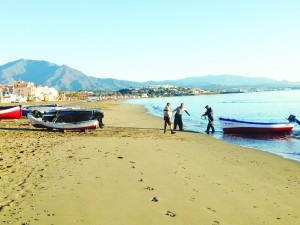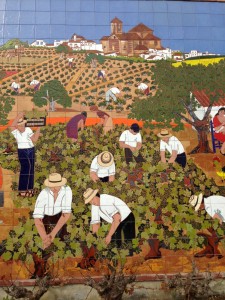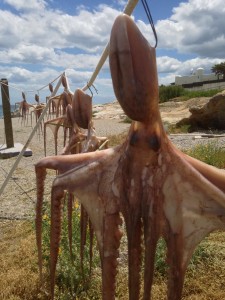- Have any questions?
- +34 951 273 575
- info@allaboutandalucia.com
Manilva: End of the line

Straight to the Europa Point: Discovering Gibraltar’s southern tip
February 23, 2015
Mijas: Ass good as it gets!
April 4, 2015
Manilva is the last resort on the Costa del Sol, but worth the visit
THE beach was groin to groin with revellers, lit up by a multitude of brightly-coloured lights and throbbing to the sound of hot dance music.
But this wasn’t the epic party island of Ibiza, or even the jet set resort of Marbella, just down the road.
It was little Sabinillas, Manilva’s younger sibling, letting her hair down at the Full Moon party last summer.
San Luis de Sabinillas, to give this up-and-coming coastal resort its full name, was just a small fishing village a decade ago; or what the Spanish call a ‘pedania’ – a tiny nucleus population dependent on a bigger ‘municipality’ – in this case, Manilva, which keeps watch over her little sister from the hills above the coast road.
Sabinillas has been around just as long as Manilva (Bronze Age artefacts have been found) but the Costa del Sol tourism boom has turned the tiny enclave into a new best-kept secret.
‘Sabi’ as the locals affectionately call the resort, remains vibrant year-round thanks to its supportive and outgoing expat community. That’s despite being at the quieter, less-developed ‘West End’ of the Costa del Sol.
It may be the last resort on this glitzy coast, but Sabi wears its community spirit on its sleeve more proudly than most others.
And every June, the full moon provides an excuse for the mother of all-night beach festivals – one to rival all the others along the coast.
With the night sky aflame with Chinese lanterns, thousands of people of all nationalities gather on this Blue Flag beach to dance, drink, dip their feet in the sea and dance some more.
But what makes Sabinillas special is its year-round appeal – close enough to Marbella to benefit from its boom, but far enough away to have carved out a positive alternate reputation for itself.
The Manilva municipality as a whole, like everywhere else on the coast, has flourished under tourism in the last decade.
But it’s a working town as well as a tourist town (it still has a small fishing fleet) where Spanish people go about their daily lives, alongside ‘los extranjeros’.

CELEBRATED: The Blue Flag beach in Sabinillas
Expats John Love and Heather Williams have lived in the village for a decade. “Manilva is the perfect place to live. It has all the benefits of Marbella without all of the pretentiousness,” says John.
“It’s the Costa del Sol’s best kept secret but it is still near to everything,” adds Heather.
It is certainly a distinct community with a healthy mix of Spanish, British and German, as well as Moroccans and South Americans.
It is also a veritable hive of commerce. While it wins no beauty awards, there is a great range of supermarkets and shops in Sabinillas.
Wall Street is the local nickname for the strip where all the banks and insurance companies are centred while, down on the waterfront, there is a great range of bars and restaurants.
British expat Debbie Porter moved to the area due to her husband Craig’s job in Gibraltar six years ago. “We decided to try it out for a year or two… but we are still here four years later!” she explains.
“There is a beautiful beach front, lots of tapas bars and a busy little village centre with everything you would need. We quickly got to know both Spanish and English people and found everyone welcoming and friendly.
“We love that there is a strong expat community for times when you feel a little home sick (and struggle with the language).
“This is also one of the nicest places to bring up a child. Kids are part of everyday life and we love spending a warm summer evening in the Plaza watching the world go by,” she adds.
For proof of this village’s rapid growth, look no further than its weekly market. It began in 1990 as a car boot sale in the car park of the Moorhouse pub. Today the Sunday morning Sabinillas market is known far and wide and is one of the biggest on the coast. It has had to change location three times simply to accommodate its expanding array of market stalls.
For further proof that this place means business, take a stroll alongside the main coastal road on the side away from the beach, where the new Olive Press headquarters resides – look out for the bright olive green sign above the much-loved Sabinillas bookshop.
Steve Davies, who has run the bookshop for four years so far, says: “Sabinillas is a great place to work and live, there’s a real community atmosphere and it’s great to have the same familiar faces popping in – and of course some new ones!”
Back on its incredible Blue Flag beach which stretches all the way from Rio Manilva to Puerto Duquesa, fishermen still launch their boats and are often met by waiting restaurateurs upon their return, eagerly awaiting the day’s catch.
A charming walk along the prom leads to the buzzing Puerto de la Duquesa, where a multi-cultural melting pot of bars and restaurants frame a sleek yachting marina.
Castillo de la Duquesa was once the site of a thriving fish processing industry, exporting highly-prized garum paste (a kind of Gentleman’s Relish). Remains of the factory, a villa and bathhouse can still be seen today.
The port remains the brightest jewel in Manilva’s crown, benefiting from tourism and buzzing with life.
Unlike any other port on the Costa del Sol, La Duquesa faces out to sea; you can see across the glittering Mediterranean to the horizon from every one of of its three sides.
The port has undergone a growth spurt in the last decade and the expansion doesn’t look like slowing down any time soon.
A veritable hub of nationalities descend on the marina to meet friends, eat out or shop during the day. And on a Friday night in the summer, this hip little harbour is as hot a place to be seen in as Puerto Banus – without the cost and hype!
Set back from the port in the mountain foothills, the community of Manilva is hugged by vineyards. Not being on most tourists’ radar, it’s refreshingly devoid of skyscraper construction. Visitors who venture off the main road to investigate may well struggle to get out of the centre’s labyrinth of narrow one-way streets where it’s easy to get lost, even with GPS navigation.
Buried in the historic heart is St Anne’s church and the adjoining cemetery, dating from around 1776. Turn a corner and there it is, striking yet simplistic, bold yet unassuming.
Sauntering through the maze of white houses with their terracotta roofs, every hola from passers-by strengthens the feeling that Manilva is still very Spanish.

RICH TAPESTRY: Mosaic showing agricultural life in Manilva
It is one step removed from the wave of tourism lapping its coast, but the quality – and price – of its tapas still draws the Sabinillas crowd.
And then there are the postcard views from every direction. The Pedreta mirador delivers a view stretching from the white cubed village of Casares to the coastal hubs of Estepona and Marbella below. A network of tracks can be glimpsed in between, inviting you to hike, cycle or horse-ride.
It is also quickly clear how important grapes and wine are to Manilva. The central Plaza de la Vendimia (Wine Harvest Square) is adorned with a spectacular mural depicting workers in vineyards, and becomes the centre of the action during the September harvest festival.
The nearby Interpretation Centre, opened in 2010, highlights and strengthens the village’s long wine-making tradition. It offers vocational courses in wine-making, aimed at inspiring the younger generations and training future professionals.
But with the right blend of tourist expansion and Spanish tradition, it is easy to see why Manilva is becoming the toast of the coast for more than just its wine.





1 Comment
What does “Blue Flag Beach” actually mean? Does it just refer to the presence of a few litter bins and showers? I like Sabinillas and have spent several summers there, but last year there was a strong smell of sewage along the shoreline near La Noria. And are the many raised manhole covers near the water there just to deal with storm surges, or for something more mundane and disgusting?